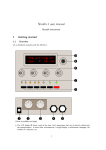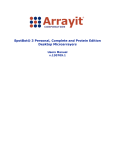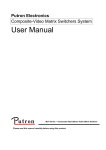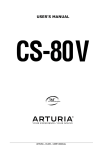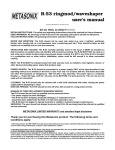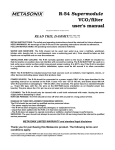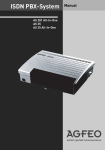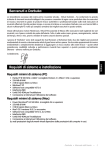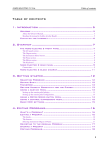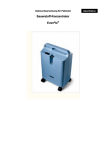Download SYSTEM A
Transcript
SYSTEM A - 100 Owner’s Manual doepfer Musikelektronik Gmbh Important safety notes E System A - 100 Warning: A doepfer Important safety notes. Inside the A-100 power supply are dangerous voltages. It is essential to take careful note of the following safety instructions: Whenever electrical equipment is used, several basic precautions need to be taken, including the following: • Before opening up the case or moving a module or blanking panel, always take the mains power supply plug out. This applies equally to removing or replacing any panel or module. • Before using any part of the instrument, read the instructions and notes carefully. • The instrument may only be used for the purpose described in this operating manual. Due to safety reasons, the instrument must never be used for other purposes not described in this manual. If you are not sure about the intended purpose of the instrument please contact an expert. • The instrument may only be operated with the voltage written on the power input on the rear panel. • Before opening the case disconnect the power plug. • All eventual modifications must only be carried out by a qualified person who will follow the valid safety instructions. Every modification should becarried out only at the manufacturer or an authorized service company. Any modification not released by the manufacturer leads to the extinction of the operation permission. • The instrument must never be operated outdoors but only in dry, closed rooms. Never use the instru- • All empty spaces in the rack must be filled with blanking panels. • Before use, the top and bottom covers must also be properly fixed in place. If modules are permanently fixed (eg. built into a 19” rack case) then the top of the highest of the rack systems and the bottom of the lowest must have their covers properly fitted. The instrument must never be operated outdoors but only in dry, closed rooms. Never use the instrument in a humid or wet environment nor near inflammables. ii doepfer • • • • • • • System A - 100 ment in a humid or wet environment nor near inflammables. Do not use this instrument in damp environments, or close to water. No liquids or conducting materials must get into the instrument. If this should happen the instrument must be disconnected from power immediately and be examined, cleaned and eventually be repaired by a qualified person Do not use this instrument in close proximity to heat sources such as radiators or ovens. Don’t leave it in direct sunlight. This instrument must be assembled or installed in a 19” rack in a way that guarantees sufficient ventilation and air circulation. The instrument must not be exposed to temperatures above 50°C or below -10 °C. In use, the instrument must be at a minimum temperature of 10 °C. Keep the top side of the instrument free in order to guarantee proper ventilation, otherwise the instrument could be overheated. Never place heavy objects on the instrument. This instrument can, without any external amplification or in combination with a headphone or speaker amplifier, produce sound levels which can damage your hearing. Don’t work at high sound levels for prolonged periods of time, and don’t ever use levels which cause discomfort. Important safety notes • The instrument’s mains power supply lead should be disconnected if it is not used for any substantial period. If there is any damage the cables must be repaired or replaced by an authorized person • Do not tread on the mains supply lead. • In disconnecting the lead, pull the plug, not the cable. • If this instrument is connected to others, check in their manuals for connection instructions. • Make particularly sure that no object falls into the instrument, and that no liquid gets into it. • Transport the instrument carefully, never let it fall or overturn. Make sure that during transport and in use the instrument has a proper stand and does not fall, slip or turn over because persons could be injured • The instrument must be checked and serviced by a qualified technician in the following cases: a. the power supply lead or connector is damaged in any way, b. an object or fluid has somehow got into the instrument, c. the instrument was exposed to rain, d. the instrument stops working properly or starts to behave erratically, e. the instrument is knocked over or dropped and/ or its case is damaged. • As stated above, there are no user-serviceable parts in the instrument. Refer all repairs to qualified service personnel. iii Contents System A - 100 Contents Important safety notes .......................................... ii doepfer 4. A-100 BS Basic Systems .................... 13 Contents ................................................................. iv About this manual ................................................... v 5. Accessories .............................................. 15 Introduction ............................................................ vi 6. Items included as standard ............... 17 1. Important notes ................................. 1 1.1 Connecting to the electricity supply ........ 1 7. Further reading ....................................... 19 1.2 Installation .............................................. 1 1.3 Care and maintenance ........................... 1 2. Overall design ............................................ 3 2.1 Introduction ............................................ 3 8. Module overview ..................................... 21 9. Appendix .......................................... 29 9.1 Adding a 5 V power supply ................... 29 2.2 Installing modules .................................. 4 9.2 Installing the AD5 low-cost 5V adaptor 31 2.3 Interconnecting modules ........................ 6 3. Signal flow in the A-100 ........................ 7 3.1 The principles of voltage control ............ 7 3.2 Signals in the A-100 ............................... 8 3.3 The System Bus in the A-100 ................ 9 3.4 Integrating the A-100 with MIDI ........... 11 iv 9.3 Using the Mini power supply/bus .......... 33 10. Using the modules H Because the A-100 is a modular system, each module has its own separate manual, which can be inserted into this ring-binder. doepfer System A - 100 About this manual This user manual describes the A-100 modular synthesizer system, and explains how to use each section of it. If this is your first time using the A-100, please make sure you are familiar with all the safety instructions (eg. pages ii - iv) and important notes (chapter 1). Because of the modular nature of the A-100, this manual is also designed to be modular. Chapter 2 (Overall design) describes the physical make-up of the system - and particularly how to install the individual modules into the 19” rack. Chapter 3 (The A-100 signal flow) details the A-100’s signal path: the basic principles of voltage control, how to bring MIDI into the equation, and the possibilities for voltage-controlled modulation. Chapter 4 describes the A-100 Basic System. Chapter 5 details accessories. Chapter 6 explains the standard items included. Chapter 7 suggests further reading. About this manual Chapter 8 (Module overview) gives a run-down of the individual modules presently available, and an idea of their potential uses. Chapter 9 (Appendix) deals with installing an extra 5V power supply, for modules such as the A-190 and A-191. Detailed descriptions of the individual modules follow, in self-contained chapters, with descriptions, user examples, and patching aids. When buying individual modules, the relevant manual chapters which are included should be inserted into this ring binder. In the manual, you’ll find various symbols used: A important user and safety advice H note ➀ ... diagram numbering of module controls ... diagram numbering of module in / outputs ❒ next step in a list of instructions P practical hint or tip v Introduction System A - 100 Introduction In the A-100, Doepfer have produced a capable and versatile analog modular synthesizer, built in the style of the classic modular systems of the seventies. The renaissance of analog synthesis in the last few years shows that analog sound production has a vital place alongside sampling and digital synthesis, and can produce sounds that are unobtainable by any other means. In addition to the unique sounds of its oscillators, filters, amplifiers, phasers, frequency shifters, wave-modifiers, different control sources, and so on, analog synthesis can provide almost unbounded modulation opportunities, conventional and unconventional - limited only by the number and variety of modules available. In designing the A-100, our priorities were: good sound quality; ease of integration into a MIDI system; diversity of modules available; and, maybe most important of all, affordability. Of course, a modular system doesn’t just have advantages. Creative work with an audio construction kit like this takes time and practice, especially to start with. vi doepfer Anyone who wants to be able to check out all its available sounds at the press of a button will be very disappointed with a modular system. Each unique sound has to be puzzled out, and may never be exactly repeated. Nor are there any fixed rules for connecting the various modules. A modular is an open system, in which practically anything is possible, and that’s where the fun really starts. Diversity and experimentation - and sometimes lateral thinking - are the keys to its power. Although the user manuals for each module are very comprehensive, they can’t substitute entirely for a general overview and knowledge of analog synthesis. Some very good specialised books have been written on the subject, and although some may be out of print, it’s crucial to find one or two of them, and learn from them. With that, the whole world of modular systems will open up to you, and you’ll suddenly appreciate their fascination and sheer sonic power. We hope your A-100 brings you serious pleasure! July, 2009 doepfer musikelektronik gmbh doepfer System A - 100 1. Important notes 1. Important information 1.2 Installation A • Do not expose the A-100 to rain or moisture. • Operation is allowed only in a dry environment in a closed room but not in the open country. • The installation near a large amplifier or other equipment which uses powerful mains transformers may cause hum. • Do not install the A-100 in close proximity to equipment which produces an electromagnetic field (monitors, computers, etc.), to avoid the possibility of mutual interference. • Use in a dusty environment should be avoided. As well as the important safety notice (see ii - iii) please also read and take note of the following points. 1.1 Connecting to the electricity supply • The system A-100 must only be connected to the mains voltage that is specified at the back of the A-100 frame (220 V to 240 V / 50 Hz or 110 to 120 V / 60 Hz). • If the fuse has to be replaced only the type of fuse specified at the back of the A-100 frame is allowed. If another fuse is used the warranty is void and the A-100 may be damaged. The fuse is located at the mains inlet on the back of the A-100 frame (exception: suitcase version with mains inlet at the front). To replace the fuse one has to disconnect the mains cable and remove the fuse holder (e.g. with the aid of a screw driver). The fuse holder is a small black plastic part that is inserted into the mains inlet. • Do not connect the A-100 to a socket or outlet which is also being used by equipment such as electric motors, lighting dimmers, etc, which can cause interference. Use a separate outlet for the A-100. 1.3 Care and maintenance • Apart from cleaning the instrument, no other usermaintenance is recommended, of the modules or system busses. Internal maintenance should be carried out only by qualified technicians (see pages ii - iii: "Important safety notice"). • For regular cleaning, use a soft, dry, or slightly damp cloth. To remove dirt, if necessary, use a cloth slightly moistened with a very diluted mild detergent. This should be more than sufficient to clean the instrument. Never use solvents like petrol, alcohol, or thinners. 1 System A -100 doepfer Fuse values for different mains voltages and power supplies Type of power supply 2 Mains voltage A-100NT12 (standard power supply, 650 mA output current) A-100PSU2 (power supply with ring core/toroid transformer and 1.2A output current) 115V 250 mA time lag (slow blow) 630 - 800 mA time lag (slow blow) 230V 125 mA time lag (slow blow) 315 - 400 mA time lag (slow blow) doepfer 2. Overall design System A - 100 2. Overall design 2.1 Introduction The A-100 modular system is based on a standard 19” rack system A-100 G into which individual Modules can be fitted in any chosen layout. The rack system (see Fig. 1) conforms to the 19” standard, and consists of two sections each 3U high, tied together by 6U side panels. It contains two system busses (1), the internal power supply (2) , and the main electrical supply socket (3). Module front panels are all 3U high. Their width is measured in HP (1 HP = 5.08 mm). The rack system has a usable width of 84 HP (see Fig. 1). If the modules you install don’t use up the entire 84 HP, then you must cover up the spaces with blanking panels. In each rack system there are two system bus bars (one for each section), to each of which up to 14 modules can be connected, using ribbon cable. The bus bar serves to supply power to the modules, and also to send control voltages etc. to some of the modules (see Chapter 3). 4 3 HU 1 2 3 1 84 HP Fig. 1: A look inside the A-100 G rack system The rack system power supply produces voltages of +12 V and -12 V and can put out a maximum current of 650 mA. In setting up a modular system, make sure that the total current required by all the modules doesn’t exceed this maximum. If it does, then a second power supply (see Accessories) will need to be installed (at position 4, Fig.1). As a rule, though, one power supply should be sufficient for a rack system. 3 2. Overall design System A - 100 H 2.2 Installing modules A Ignoring this warning can result in damage to your system, and will void your guarantee! Important: Once you’ve checked that there is sufficient current in reserve for the extra module/s, there’s nothing to stop you going ahead and installing them. Read on! Before you install a module into the rack system: D First of all, take the A-100’s plug out of the wall socket. D Calculate the total current requirement of existing modules plus the new module/s. D Plug the supplied ribbon cable into the module’s bus socket (see 1 in Fig. 2). As a rule, the cable is 16-way, but some modules only have a 10-way cable. Look carefully at the cable, and then press the appropriate connector onto the module’s bus pins (see 2 in Fig. 2). D Check that this total is less than 1200mA. D If it is, the existing power supply is fine. D But if the total current requirement is more than 1200 mA, you must install a second power supply (see Accessories) before installing the module/s. Follow the installation notes that come with the second power supply. 4 doepfer A Check very carefully that it is connected so that the coloured marking on the ribbon cable is at the bottom of the module’s connector (see 3 in Fig. 2), and that the connection is perfect, and pushed fully home, not at a slight angle. Failure to check this may result in the module’s instant destruction as soon as the power is turned back on. doepfer 2. Overall design System A - 100 Bus Board Fig. 2: Connecting the ribbon cable to the module D Now join the free end of the ribbon cable (see 2 in Fig. 3) to the nearest available position on the system bus board (see 1 in Fig. 3). A Check very carefully that it is connected so that the coloured marking on the ribbon cable is at the bottom of the bus connector (see 3 in Fig. 3), and it is pushed fully home, not at a slight angle. Failure to check this may result in the module’s instant destruction as soon as the power is turned back on! Fig. 3: Connecting the ribbon cable to the bus board. H When you’re installing extra modules, it may be necessary to take another module or two out, to allow you easier access to the bus board. D Place the module carefully into the space in the rack, and fasten it firmly in place with the supplied screws. Put back any covers or blanking plates, and screw them in firmly. D Now plug the system A-100 back into the main power supply, and switch it on. D Test out the newly installed module. If it doesn’t seem to be working as expected, immediately disconnect the system from the power supply again. 5 2. Overall design System A - 100 A-110 In this case, double-check the connections, making completely sure that the ribbon cable is the right way round where it connects to the module and the bus. doepfer VCO A-118 STANDARD VCO -2 SYNC Range NOISE / RANDOM White Blue 0 0 Tune 0 Colored 0 10 CV 2 Rate CV 3 0 10 Level 0 Audio In Random Output VCO STANDARD VCO 10 0 A-145 LFO 0 lin In 1 A 10 0 10 0 10 0 10 0 10 In 2 10 Input 3 Output In 3 S 0 PW 10 Input 4 Output 10 0 Reset In H L 10 Frequ. Range In 4 R Frequ. M 0 Inverse Output H 10 Output L M ADSR Control Time Range Fig. 4: Example of a personal patch sheet. 6 10 D 10 10 0 Input 2 Retrig. 10 PW CV 2 0 exp Input 1 0 0 10 Out 10 ADSR A-138 MIXER A-140 0 Tune PW CV 2 0 Res. Gate Range CV 2 PW CV 1 10 In 2 10 0 0 0 In 1 Audio Out Random + Control - +2 0 10 Audio In 2 Audio Out 10 -2 0 Lev. 0 SYNC 10 CV 1 10 PW CV 2 A-110 0 Audio In 1 10 0 10 CV 3 PW PW CV 2 Gain 0 CV 2 10 CV 2 For connecting modules to each other, you need mono mini-jack (∅ ∅ 3.5 mm) patch leads. You can obtain patch leads from us (see Accessories in chapter 5) in different lengths. 10 10 0 CV 1 2.3 Interconnecting modules 0 CV 2 0 0 Photocopy the patch sheets for each of your modules, cut these out, and stick them onto a sheet of paper in the order in which they occur in your system (see Fig. 4). Then photocopy this sheet, and use the copies to note down good settings and patches. 10 Red CV 2 Once your system is assembled and operational, you should make use of the the patch sheets which come with each module. CV 1 10 CV 2 PW CV 1 LOW PASS FILTER CV 1 Freq. +2 CV 1 VCF 1 A-130 VCA-LIN. A-120 Out doepfer System A - 100 3. Signal flow in the A-100 Input 3. A-100 signal flow Low Pass Filt er f c VCO Output Pit ch Output 3.1 The Principles of Voltage Control What makes analogue synthesizers (and modular systems in particular) special is that the important parameters of the sound sources (VCO, noise, etc.) and modifiers (VCF, VCA, etc.) can be altered not just by hand, but by voltage control. This principle was turned into reality by the “father of the analogue synthesizer”, Robert Moog, who produced the first commercially available synthesizer in the sixties. It gives vast flexibility and the potential to make sounds that have never been made before. Fig. 5 shows the principle of voltage control, with examples of control voltages affecting a filter (VCF) and an oscillator (VCO). In the case of the VCF, the parameter which is being voltage-controlled is the Cut-Off Frequency fc. The amount of control voltage input present changes the cut-off frequency, and thus the frequency of the signal that the VCF lets through - see the shaded area in the diagram. CV Input CV Input CV CV t t Out fc Freq . fc Freq. Fig. 5: The principles of voltage control In the case of the VCO, it’s the pitch which is controlled by a voltage: an increase of 1 volt corresponds to an increase of one octave in the pitch. With a sudden change of voltage, the pitch changes suddenly, while with a smoother, continuous change, portamento is created. 7 3. A-100 signal flow System A - 100 doepfer As well as modules which can be affected by voltage control, there are other modules like the ADSR and LFO which themselves produce voltages to control other modules. 3.2 Signals in the A-100 Usually, these modules need a Trigger Signal to bring them into action. For instance, a GATE Signal, corresponding to a key being pressed on a keyboard, can set off an ADSR, which then puts out its variable voltage “envelope” to affect other modules (see Fig. 6). • Control voltages In the System A-100 there are three types of signal: • Audio Signals • Trigger voltages Audio Signals are produced by the sound source Modules (such as VCO or NOISE), and lie in the range from -5 V to +5 V (10 VSS). The System A-100 can also let you use external Audio Signals (e.g. Microphone, Electric Guitar, Keyboard). GATE GATE ADSR CV Out H +5V 0V On Off t CV Out To interface satisfactorily, the level of external Audio Signals must be brought up to the A-100’s operating level. Module A-119 (External Input), is ideal for this job, having among other things an internal pre-amp, and two inputs of different sensitivity. t Fig. 6: The envelope generated by an ADSR 8 Control voltages, as produced by modulation sources like the LFO and ADSR, are typically from -2.5 V to +2.5 V (5 VSS) for the LFO, and from 0 V to +8 V for the ADSR. doepfer System A - 100 Trigger or Gate Signals, which start a process or function, are typically from 0 V to +5V or 0V to +12 V, with the trigger occurring as the leading edge of the waveform shoots up from 0 V to +5V/12 V. The A-100 modules usually output +12V, but the corresponding inputs of A-100 modules (e.g. Gate, Clock, Reset) will also work with lower levels (typ. +5V). These definitions of the various signals, and the distinctions between them - sound sources and modulation sources - are right in principle, but a modular system like the A-100 often makes a mockery of them. In a modular set-up, all of the modules produce voltages, and can be used as control voltages or triggers, thus blurring the distinction between the various types. For example, the output from an LFO can be used as an audio signal, as a control voltage for a VCF or VCA, or as a trigger signals for a sequence. It’s just about true to say that anything can be modulated by anything else, so that a modular system gives the musician extraordinary flexibility and individuality. 3. A-100 signal flow 3.3 The System Bus in the A-100 The A-100’s System Bus supplies power to the modules. It also carries the internal control system (INT.GATE and INT.CV), which some of the modules (such as the VCO A-110, or ADSR A-140) can tap into. You can choose whether these modules receive these signals, by altering an internal jumper. 1 7 J1 8 J2 14 INT. Gate INT. CV +5 V +12 V GND -12 V Fig. 7: The A-100 system bus If you use the A-190 MIDI-/CV-Interface in your system, when you press a key on your MIDI keyboard, the gate and CV1 signals from the A-190 will be sent via the INT.GATE and INT.CV to all modules on the bus. The INT.GATE and INT.CV signal busses can be split into two equal halves by removing jumpers J1 and J2 (see Fig. 7), so that for each whole bus, you can have two separate CV/GATE subsystems. 9 3. A-100 signal flow System A - 100 doepfer If on the other hand you’d like to have the same internal CV and gate available on two busses at once, you need to link the two together, with the special CV/gate leads, the A-100 BC. This is how you go about it: D Remove the A-100 from the electrical supply. D Remove Jumpers J1 and J2(see p.9) from the upper (see Fig. 8 !) and lower (see Fig. 8 ") system bus boards. ➀ ➁ D Replace the jumpers with the special CV / gate leads, A-100 BC (see Fig. 8 1, 2). A 10 Make absolutely sure that you connect the leads correctly, joining up the upper INT CV with the lower INT CV, and the upper INT GATE with the lower, to avoid possible damage when you switch back on! Fig. 8: Making a common INT.CV and INT.GATE signal path between the upper and lower busses. doepfer System A - 100 3.4 Integrating the A-100 with MIDI To link the A-100 into a MIDI system, you can use external MIDI interfaces like our MCV4, MSY2 or MCV24. The MIDI-CV/SYNC Interface A-190-1 is a MIDI-toCV/Gate/Sync interface with the following outputs: • CV 1 (for pitch control, 12 Bit) • CV 2 (any MIDI-Controller, 8 Bit) • Gate • Clock • Start / Stop The A-190 automatically sends pitch control CV and gate information out on the INT.CV and INT.GATE busses. 3. A-100 signal flow VC Modules like the A-141 VC-ADSR and A-147 VC-LFO can be controlled via the A-190-1 or A-190-2, so that, for instance, a continuous MIDI controller can alter envelope parameters in real time. Since these controllers can be recorded by a MIDI sequencer, VC modules are effectively programmable. Analog sequencing can be provided by the A-155 or the external MAQ 16/3 MIDI Analog Sequencer. To convert up to 16 control voltages in the range 0...+5V (e.g. from a Theremin A-178 or Joy-Stick A-174-1 or Foot-Controller A-177-2 or ribbon controller A-198) into MIDI controllers the CV-to-MIDI interface A-192 is the right choice. Another solution is the usage of the low cost MIDI-CV Interface A-190-2 which has one Gate and four CV outputs available. Another suitable MIDI-CV Interface for A-100 was the 24-channel MCV24, a 19” rackmount with its own power supply. As the MCV24 is no longer in production you will have to try to find a second hand unit. 11 3. A-100 A-100signal signalflow flow 12 System A - 100 doepfer doepfer System A - 100 4. A-100 Basic Systems It’s not in the nature of modular systems to have hard and fast rules about which modules should be included. But if you’re just starting out along the modular path, it may be difficult to choose a sensible first set of modules. Accordingly, we’ve designed Basic Systems with all the modules mounted in a rack system, and 30 patch leads thrown in as well. For an exact run-down of the modules included in Basic System 1 (A100BS1), see the table on the right of this page, and the illustration on the next page. To integrate BS1 it into a MIDI system, you would need a separate MIDI interface, such as an MCV4 or MCV24. In the Basic System 2 (A-100BS2) the MIDI interface A-190 is included (instead of A-150 and A-162). We also have available a small Mini System (A-100MS). See our topic prospectus for details. The purpose and function of other modules will become more apparent as you work with your system, and you will be able to decide which extra modules you need for your particular purposes. In the future other types of complete systems may be available. We are planning an Expansion System containing nearly all modules not included in the Basic Systems, a Vocoder System and a Sound Processing System without VCO’s for external audio signals. 4. A-100 Basic System Pos. Quantity Module Function HP 2 A-110 VCO 20 1 A-114 Dual Ring Modulator 4 u 1 A-115 Audio Divider 8 p 1 A-116 Waveform Processor 8 p 1 A-138b Mixer (log) 8 e 1 A-120 VCF 1 - 24 dB Low Pass 8 r 1 A-121 12 dB Multimode Filter 12 1 A-130 VCA (lin) 8 1 A-131 VCA (log) 8 1 A-118 Noise / Random 8 1 A-148 Dual Sample & Hold 4 l 2 A-145 LFO 16 o 1 A-160 Clock Divider 4 w 1 A-161 Clock Sequencer 4 e 1 A-180 Multiples 4 r 1 A-138 a 1 A-170 Mixer (lin) 8 Dual Slew Limiter 8 1 A-150 Dual VCS 4 1 A-162 Dual Trigger Delay 8 2 A-140 ADSR 16 13 4. A-100 BS Basic system 14 System A - 100 doepfer System A - 100 doepfer Part 5. Accessories Description A-100BUS Separate system bus One bus board with 14 connectors for connecting modules, 3 control LEDs (+12,-12,+5V) A-100AD5 5V Low cost adapter Additional power supply producing +5 V / 100 mA; can be connected to any free socket on the system bus board. For modules which require 5V (eg. A-113, 190, 191). This is a cheaper alternative to the NT5 +5 V power supply. A-100NT5 Separate 5 V power supply +5 V / 500mA additional power supply, assembled and tested. A-100PSU2 Separate 12 V power supply +/-12 V 1200mA additional power supply, assembled and tested. A-100B... A-100B84P A-100C ... Blanking panels / back panels B1: 1 HP / B2: 2 HP / B4: 4 HP / B8: 8 HP / B42: 42 HP / B84: 84HP Back panel for power supply Punched ready for power supply installation, with switches, safety fixings, and power supply connection cable. Patch lead Leads with two moulded 3.5mm plugs C30: 30 cm / C50: 50 cm / C80: 80 cm / C120: 120 cm continued on next page ... Subject to change without notice 15 5. Accessories Part A-100OPM A-100SM 16 System A - 100 doepfer Description A-100 User Manual Contains detailed description and instructions for use of all the currently available modules. It is included when you buy a complete system (A-100BS1, BS2, MS). When buying individual modules or frames, you have to order the manual separately. If you order the manual in advance the price for the manual will be credited when ordering a complete system later (not only a single module). A-100 Service Manual Contains the schematics, silk screens, parts lists, assembly, test, basic principles and adjustment instructions of all currently available modules. The words (e.g. assembly instructions) are in German language but schematics, components overlays and parts lists are international. Available only to A-100 customers. Subject to change without notice doepfer System A - 100 6. Standard items included 6. Items included as standard A-100G3/G6 - Rack System 3HU/6HU The following parts are included in each order: • Rack system, completely assembled, including two system bus boards, one 12V, 650mA power supply, internal power cables. A-100BS1/BS2/MS - Basic Systems • Rack system (basic frame), completely assembled, including two system bus boards, one 12V, 650mA power supply, internal power cables. • External power lead. • +5V supply is not included • All modules specified for the System (BS1, BS2 or MS) completely assembled, tested and mounted into the frame A- XXX - any module • 30 patch leads for A-100BS1 and BS2 • Ribbon cable for connection to the system bus. • 15 patch lead for A-100MS • External power lead. • Complete instruction manual (containing the manuals of all modules) • Module A-XXX. • Fixing screws. The instruction manual is not included when ordering a single module or frame. In this case the complete instruction manual has to be ordered additionally! • +5V supply is not included (only the +5V low cost adapter for A-100BS1 and MS) 17 6. Standard items included 18 System A - 100 doepfer doepfer System A - 100 7. Further reading The resources in the following list should help you increase your knowledge of analog synthesis, and the skill with which you can use modular systems like the A-100. Specialist books In English 7. Further reading Synthesizer Technique ISBN 0-88188-715-3 and Synthesizer Basics ISBN 0-88188-714-5 - (revised re-prints of very useful and authoritative articles from Keyboard magazine, by Moog, Rhea, Milano, Coster, Duke, Powell, Gleeson, DeFuria, Anderton, et al.) Crombie, The Synthesizer & Electronic Keyboard Handbook ISBN 0 330 28681 1, and The New Complete Synthesizer ISBN 0-7119-0701-3 (The latter especially is a good general introduction.) Allen Strange, Electronic Music Systems, Techniques and Controls, 2nd edition, Wm. C. Brown Co. Publishers, Iowa, USA. ISBN 0-697-03602-2* Trythall, Principles and Practice of Electronic Music, 1973, ISBN 0-448-40002-6 (an early classic.) This book by Allen Strange is very comprehensive and thoroughly recommended, because as well as all of the basics it also includes a huge number of patches and practical tips. It’s easy to read, instructive and very well organised. If your bookstore has trouble ordering a copy, then try the publishers. In Europe, try McGraw-Hill Publishing, tel +44 (0)1628 502500; or Susurreal, tel +44 (0)1363 774627), who had copies at £25 including postage in late 1996. Forrest, The A-Z of Analogue Synthesisers, Part One (A-M), ISBN 0 9524377 0 8*, and Part Two (N-Z), ISBN 0 9524377 1 6* : Susurreal, England. tel +44 (0)1363 774627, fax +44 (0)1363 777872, email: [email protected] (A background read rather than great technical help.) Vail, Vintage Synthesizers, GPI Books / Miller Freeman Inc. San Francisco, 1993, ISBN 0-87930-275-5* (A background read rather than great technical help.) Chamberlin, Musical applications of microprocessors, Hayden Book Company, Rochelle Park / New Jersey, 1980, ISBN 0-8104-5773-3 * Only the books whose ISBN numbers are followed by an asterisk are definitely in print as of Dec 1996. 19 7. Further reading System A - 100 doepfer Specialist books in German Elrad, Heise-Verlag Hannover Dellmann / Thewes, Synthesizer-Handbuch, Musik Media / Augsburger Druck- und Verlagshaus, 1985 Electronic Musician, Polyphony Publishing Co., Oklahoma City / USA Enders, Die Klangwelt des Musiksynthesizers, Franzis-Verlag München, 1985, ISBN 3-7723-7761-0 Electronics and Music Maker / Music Technology, Cambridge, England. Chapman, Formant Musik-Synthesizer, ElektorVerlag Aachen, 1979, ISBN 3-921608-10-4 Polyphony, Polyphony Publishing Co., Oklahoma City / USA Aigner, Formant Musik-SynthesizerErweiterungen, Elektor-Verlag Aachen, 1981, ISBN 3-921608-19-8 Synthesource (Curtis/CEM house magazine) Becker, Synthesizer von gestern, Musik Media Verlag Augsburg, 1990, ISBN 3-927954-00-4 Becker, Synthesizer von gestern Vol. 2, Musik Media Verlag Augsburg, 1995, ISBN 3-927954-01-2 A very good introduction to the basic techniques and programming methods of digital and analogue synthesis can be found in the 120-minute video "The Secrets of Analog and Digital Synthesis" by Steve deFuria (VH017, Warner Bros.). Specialist magazines The following useful magazines can mostly only be found second-hand or may possibly be available in some libraries, for photocopying articles. Elektor, Elektor-Verlag Aachen 20 Video 8. Module Overview System A-100 The following table may be used for planning and arranging an A-100 system regarding to need of space and current. 8. Module Overview (as of July 2009) Module A-101-1 A-101-2 A-101-3 A-101-9 A-102 Width Current Current@5V [mA] [mA] [HP] 16 8 30 8 8 DOEPFER 30 20 50 40 30 Description - Vactrol Steiner Filter - Lowpass Gate - 12-Stage Modular Vactrol Phase Filter - Dual Universal Vactrol Module - Diode Lowpass (combined manual A-102/A-103) Vactrol filter with different inputs (!) for low/band/highpass Combination of lowpass and VCA with vactrol (vactrol = LED/LDR- combination) Modular phaser with separate in/outputs for each stage and 2 polarizers 4 voltaged controlled resistors for modification of other modules voltage controlled 18 dB low pass with diodes as frequency controlling elements A-103 8 30 - 18 dB Lowpass (combined manual A-102/A-103) A-104 20 30 - Trautonium Formant Filter - SSM 24 dB Lowpass (combined manual A-105/A-122) A-105 8 20 A-106-1 14 40 - A-106-5 8 30 - A-106-6 A-107 12 26 50 200 - voltage controlled 18 dB low pass (with TB303 type transistor ladder) Quad Low/Band Pass Filter as used in the so-called Trautonium (see A-113) voltage controlled 24 dB low pass with the legendary SSM2044 circuit X-treme filter voltage controlled MS20 filter clone, low/highpass simultaneously, +/- clipping controls SEM filter voltage controlled 12 dB filter (SEM type), lowpass/notch/highpass with mixer, bandpass XP filter voltage controlled filter (XP type) with 15 different filter types Multitype Morphing Filter voltage controlled multitype filter with 36 different filter types and morphing feature 21 System A-100 DOEPFER Module Width Curr. Curr.@5V A-108 12 40 - A-109 20 40 - A-110 10 70 - A-111-1 14 40 - A-111-5 26 80 - A-112 50 - A-113 26 30 100 A-114 4 40 - A-115 8 20 - A-116 8 20 - A-117 8 20 - A-118 A-119 A-120 22 10 8 8 8 20 30 30 - 8. Module Overview Description 6/12/24/48 dB Low Pass / Band Pass voltage controlled low pass (ladder type) with 4 different slopes and bandpass Voltage Controlled Signal Processor combination of 24 dB low pass, VCA and panning unit (CEM3379 based) VCO (Standard) voltage controlled Oscillator with 4 different waveforms, hard-sync input VCO (High End) like A-110 but improved waveforms, linear FM input, soft-sync input Synthesizer Voice miniature synthesizer voice with VCO, VCF, VCA, ADSR and two LFOs SAMPLER 8 bit sampler and wavetable oscillator Submarmonic Generator Sound Generation unit as used in the so-called Trautonium (4 subharmonic oscillators) Dual Ring Modulator 2 separate ring modulators Audio Divider frequency divider for audio signals (rectangle waveforms) WP - VC Waveform Processor module for dynamic waveform modification DNG / 808 - Digital Noise / Random Clock / 808-Source digital noise and clock generator, 808-like sound source Noise / Random analog noise generator with white and adjustable colored noise, random voltage External Input / Envelope Follower Input module for external audio signals, includes envelope follower and gate generator VCF 1 - 24 dB Low Pass 1 voltage controlled 24 dB low pass (Moog type) 8. Module Overview System A-100 Module Width Curr. Curr.@5V A-121 12 30 - Description VCF 2 - 12 dB Multimode Filter - VCF 3 - 24 dB Low Pass 2 (combined manual A-105/A-122) A-122 8 20 DOEPFER voltage controlled 12 dB multimode filter (low pass, high pass, band pass, notch) voltage controlled 24 dB low pass (with CEM3320, Oberheim type) A-123 8 20 - VCF 4 - 24 dB High Pass (module no longer available)voltage controlled 24 dB high A-124 8 30 - VCF 5 - 12 dB Wasp Multimode Filter pass reproduction of the strange multimode filter used in the EDP Wasp Synthesizer A-125 8 20 - VCP - Voltage Controlled Phaser A-126 8 80 - VCFS - Voltage Controlled Frequency Shifter - VCRF - Triple Voltage Controlled Resonance Filter - Fixed Filter Bank - Vocoder Analysis Section A-127 A-128 A-129-1 28 20 20 100 20 100 voltage controlled FET based phase shifter with resonance voltage controlled analog frequency shifter 3 independent voltage controlled band pass filters with 3 LFOs filter bank with 15 band filters Analysis section of the modular vocoder A-129-2 12 80 - Vocoder Synthesis Section A-129-3 16 40 - Vocoder Slew Limiter - SLC - Slew Limiter Controller - VUV - Voiced / Unvoiced Detector A-129-4 A-129-5 8 8 30 30 synthesis section of the modular vocoder universal 5-fold voltage controlled slew limiter/attenuator/offset generator controller module for slew limiter function of A-129/3 module for recognition of "voiced/unvoiced" speech 23 System A-100 DOEPFER Module Width Curr. A-130 8 20 voltage controlled amplifier with linear response VCA - Voltage Controlled Amplifier 8 20 - A-132-1 4 20 - Dual Low Cost VCA - Quad VCA A-132-3 8 8 30 30 - voltage controlled amplifier with exponential response two simple voltage controlled amplifier with linear response four VCAs with independent inputs and outputs, common loudness/level control Dual linear/exponential VCA two separate VCAs with selectable control scale (switch, linear or exponential) A-133 8 30 - Dual Voltage Controlled Polarizer A-134-1 8 40 - VC PAN - Voltage Controlled Panning / Crossfader two special VCAs with positive and negative (=inverting) amplification module for voltage controlled panning or crossfading A-134-2 4 20 - Dual VC Crossfader A-135-1 22 30 - VC MIX - Voltage Controlled Mixer A-135-2 24 Curr.@5V Description VCA - Voltage Controlled Amplifier - A-131 A-132-2 8. Module Overview ? ? - A-136 8 30 - A-137-1 14 40 - A-137-2 14 30 - Two separate voltage controlled crossfaders 4 separate VCAs with common output VCF/VCA/Panning subsystem (still under development) subsystem with VCFs with VCQ, VCAs and VC panning units with common stereo output Distortion/Waveshaper distortion and wave-shaping / wave-modifying module with extensive control possib. Voltage Controlled Wave-Multiplier I waveform multiplier with 4 VC parameters: Multiples, Harmonics, Folding, Symmetry Voltage Controlled Wave-Multiplier II makes one sawtooth VCO sound like five VCOs (four VC algorithmic phase shifters) 8. Module Overview Module A-138 a/b/c A-138d A-138e Width Curr. 8 10/20c 8 16 20 10 System A-100 Curr.@5V Description Mixer, mixer for audio or control voltages - (a: linear or b: logarithmic controls or c: polarizing mixer) - A-138m ~20 ~? - A-138x 8 0 - A-139 8 100 - A-140 8 20 - A-141 14 30 - A-142 8 40 DOEPFER - A-143-1 28 70 - A-143-2 26 70 - A-143-3 14 70 - A-143-9 8 30 - Manual Crossfader / Effect Insert Module manually controlled crossfader and module to insert external effect units Quad Three-Way Crossfader / Mixer / Polarizer four separate three-way crossfader (i.e. fading between 3 different input signals) 4 x 4 Matrix Mixer (still under development) matrix mixer with four inputs and four outputs, each row can be switched to uni/bipolar Mix Expander expanding unit for A-138a/b, expands the number of available inputs to 9 Headphone Amplifier (module no longer available) stereo headphone amplifier with separate level and common loudness control ADSR - Envelope Generator envelope generator with 4 parameters: attack, decay, sustain, release; retrigger function VC-ADSR - Voltage Controlled Envelope Generator voltage controlled envelope generator with 4 voltage controlled parameters VC Decay voltage controlled envelope generator with one voltage controlled decay Complex Envelope Generator / Quad AD Four daisy chained AD type envelope generators with polarizing mixer Quad ADSR Four ADSR envelope generators with EOA/EOD/EOR gate outputs and retrigger feature Quad LFO Four LFO modulation oscillators with triangle, rectangle and saw outputs, range switch Quadrature LFO/VCO voltage controlled LFO/VCO, four sine outputs with 90 degrees phase shift between e.a. 25 System A-100 DOEPFER Module Width Curr. A-144 8 30 A-145 A-146 A-147 8 8 30 20 40 Curr.@5V Description Morphing Controller - control voltage modifier to obtain morphing effects in combination with A-135 - LFO 1 - LFO 2 - VCLFO modulation oscillator with 5 waveforms modulation oscillator with 2 waveforms and waveshape control voltage controlled modulation oscillator with 4 waveforms A-148 4 20 - Dual S&H A-149-1 12 40 - Quantized/Stored Random Voltages A-149-2 4 40 - A-150 4 30 - A-151 4 20 - A-152 A-154 A-155 A-156 26 8 16 22 50 8 40 60 100 50 8. Module Overview - two independent sample & hold devices Replica of the legendary Buchla module "Source of Uncertainty" (part 1) Digital Random Voltages expansion module for A-149-1, generates 8 digital random voltages/gates (high/low) Dual VCS - Voltage Controlled Switsches two independent voltage controlled switches Quad Sequential Switch electronical "rotary switch" with 4 positions Voltage Addressed Switch electronical 8-fold "rotary switch" with voltage controlled addressing Enhanced Sequencer Controller Expansion module for A-155, adds additional running modes and features to A-155 Analog / Trigger Sequencer 8 step analog and trigger sequencer Dual Quantizer two control voltage quantizers with special selection features 8. Module Overview Module Width Curr. A-160 4 40 A-161 A-162 A-163 A-164-1 4 8 8 6 20 40 40 10 System A-100 Curr.@5V Description Clock Divider - frequency divider for clock/gate signals - A-165 4 20 - A-166 8 40 - A-167 8 20 - A-170 8 20 - A-171 8 20 - A-172 4 10 - A-174-1 10 40 - A-174-2 ~14 ~20 DOEPFER - Clock Sequencer clock sequencer expansion for clock divider A-160 Dual Trigger Delay two independent trigger delay devices Voltage Controlled Divider divides the frequency of an audio signal by an integer factor controlled from a CV Manual Gate Module three manually generated gate/trigger signals Dual Trigger Modifier two independent trigger modifiers (inverter + transition edge detector) Logic Module dual module with logical AND/OR/EXOR combinations + 2 logical inverters Analog Comparator/Offset-Generator/Subtractor compares the difference of two voltages with fixed value and generates a gate from this Dual Slew Limiter two independent portamento controllers or integrators VC Slew Limiter voltage controlled portamento controller/integrator Maximum/Minimum Selector selects from up to 4 analog inputs the maximum and minimum voltage Joy Stick module with 2 separate CV outputs controlled by the X/Y position of the joy stick Wheels Module (still under development) 2 wheels, factor setting: one with, one without reset spring, uni- or bipolar CV output 27 System A-100 DOEPFER Module Width Curr. A-175 4 20 28 Curr.@5V Description Dual Voltage Inverter - two independent analog voltage inverter with displays A-176 8 20 - A-177-1 8 30 - A-177-4 4 ~ 20 8. Module Overview - A-178 8 60 - A-179 8 60 - A-180 4 - - CVS - Control Voltage Source 3 manual adjustable control voltages External Foot Controller I (module no longer available) interface module for 2 foot controlers and one double foot switch External Foot Controller II (still under development) simple interface module for one foot controller and one double foot switch Theremin Control Voltage Source variable voltage/gate source controlled by hand movement Light Controled Voltage Source (module no longer available) variable voltage/gate source controlled by light intensity Multiples I 8-fold multi connector (may be splitted into two 4-fold multi connectors) Multiples II A-181 4 - - A-182 6 0 - Switched Multiple A-183-1 4 0 - Dual Attenuator (still under development) two simple passive attenuators A-183-2 4 ~ 20 - A-183-3 4 ~ 20 - A-185-1 4 30 - A-185-2 6 30 - two multiples with 3.5 mm and 1/4“ mono and stereo sockets eight sockets that can be switched to one of two busses or turned off Offset Generator + Attenuator/Polarizer (still under development) generates an offset voltage that is added to an attenuated or inverted input voltage Amplifier (still under development) simple DC coupled amplifier with adjustable gain, max. gain can be swithed to 1,2 or 4 Bus Access Module module for access to bus signals CV and gate Precision Adder / Bus Access high precision CV adder (0,1%) with four inputs and optional access to bus CV 8. Module Overview System A-100 Module Width Curr. A-186 4 0 A-187-1 ? ? A-188-1 14 80 - A-188-2 30 120 - A-189-1 8 60 Curr.@5V Description Gate / Trigger Combiner 7 inputs that are "OR-wired" to the output, mainly for combination of gate/trigger signals Voltage Controlled DSP Effects Module (still under development) DSP based effects module with four voltage controlled parameters - A-190-1 10 10 • / 50 A-190-2 6 30 - A-190-3 ? ? DOEPFER - A-191 12 30 • / 50 A-192-1 12 100 - BBD Module BBD module, available with 6 different BBD circuits from 128 to 4096 stages Tapped BBD Module BBD module with 6 taps, single outputs and two (stereo) submixers Voltage Controlled Bit Modifier 16 different voltage controlled bit modification effects (e.g. bit cruncher) with VC sample rate MIDI-CV/SYNC-Interface MIDI-to-CV and sync interface MIDI-CV-Interface low cost MIDI-to-CV interface with manual glide control and four CV outputs Polyphonic MIDI/USB-CV-Interface (still under development) Midi-CV interface with four CV and gate outputs, different monophonic/polyphonic modes MIDI-CV-Interface/Shepard Generator (module no longer available)16-fold MIDI-to-CV interface and Shepard generator Voltage-to-MIDI Interface 16 CV inputs (0...+5V) are converted into MIDI control change messages CV/Gate-to-Midi/USB-Interface (still under development) A-192-2 ? ? - converts CV/Gate signals into Midi note messages A-195-1 ? ? - Pitch-to-CV/Gate/Midi/USB-Interface (still under development) converts clean monophonic audio signals into CV/Gate/Midi/UBS 29 System A-100 DOEPFER Module Width Curr. A-196 8 40 A-197-1 14 50 - A-197-2 34 100 - A-198 8 40 - A-199 30 10 80 8. Module Overview Curr.@5V Description Phase Locked Loop Module (PLL) - linear VCO + 3 phase comparators + lowpass in the form of a so-called PLL circuit - Analog Meter (module no longer available)Analog display (moving coil instrument with back light), 3 display modes LCD Scope (available only as kit without the scope) kit to install a Velleman LCD scope into the A-100 system Trautonium / Ribbon-Controller Trautonium manual resp. ribbon controller, made of module + manual Spring Reverb electronically simulated reverb by means of 3 spiral springs 8. Module Overview System A-100 DOEPFER 31 DOEPFER 32 System A-100 8. Module Overview doepfer System A - 100 9.1 Adding a 5V power supply Some A-100 modules, for instance the A-113, A-190 or A-191, need an extra 5 V power supply, as well as the standard one. You can provide this with the A-100 NT5 5 V supply (or in certain circumstances, you can use the 100 AD5 5 V adaptor - see 9.2). A If you are considering installing and connecting the NT5, it’s crucial to take note of the following safety instructions: • The installation and connection of the NT5 must only be carried out by a qualified electrician or technician. • If no suitable expert is available, the rack must be sent to a service centre or direct to Doepfer Musikelektronik for the power supply to be fitted. • Danger! Before installation and connection of the power supply, it is essential that the whole rack is isolated completely from the mains current. 9. Appendix The 5V power supply needs to be mounted near to the main power input, on the blank upper back panel with four stand-offs, nuts, serrated washers, and bolts. Newer back panels (about since summer 1999) are already equipped with 4 monting holes required for the 5V supply. For back panels manufactured earlier the 4 holes have to be drilled to receive the power supply fixing bolts (Ø from. 3 to 3.5mm). The NT5 connection diagram (Fig. 10) is on the next page. Check again that the rack is totally disconnected from the mains power supply, then:D Remove the two 115/230V mains cables (normally blue and black or brown cables) from the 12V power supply mains input, and reconnect them to the corresponding mains connectors on the 5V supply. The case shield / GND cables/connections remain unchanged as the shielding is connected directly to the metal frame (the yellow/green cable). D Join up the two parallel connectors from the 5V mains input to the mains input of the 12V supply (using the correct wires from the blue and black or brown ones supplied). D Connect the two low voltage outputs of the 5V supply (ground and +5V) to the system bus board which requires the 5V supply. 29 9. Appendix t o t he connect ors of t he bus board System A - 100 doepfer GND (black ) blue blue +5 V (re d) black black or brown blue blue Fig. 10: NT5 power supply connections 30 black black or brown f rom m ains inlet doepfer A System A - 100 9. Appendix The yellow/green wire is the safety (earth) connection, and must be never replaced by a different colour. ➂ up oben If you’ve been using the AD5 low-cost 5V adaptor, but are now installing an NT5, you must remove the AD5 before commissioning the NT5! ➀ ➁ rotered Markierung mark 9.2 Installing the AD5 low-cost 5V adaptor The AD5 can be used for the 5V power supply, as long as the following applies: • The current for the modules that require a 5V supply doesn’t exceed 100 mA (e.g. only one A-190 or A-191) • There is enough current handling still available on the +12V supply to cope with the current requirements of the 5V modules. The AD5 adaptor can be connected to any available 16-way socket on the system bus board (see Fig. 11). This will feed +5V to modules on that bus, as long as their current requirements don’t exceed 100mA. Fig. 11: Connecting the 5V low-cost adaptor (1: system bus board, 2: AD5, 3: heat sink) To install the AD5, do the following: Isolate the A-100 rack from the mains power supply by removing the main plug. D Carefully insert the AD5 into a free socket on the bus board. A Make sure that the AD5 is the right way up, and aligned correctly with the bus socket. The correct position is shown on a sticker (with the arrow pointing upwards, and the red mark at the bottom - see Fig. 11). 31 9. Appendix System A - 100 The fins of the heat sink should be facing to the right. It’s vital to make certain that the 16-way plug and socket marry exactly, and aren’t displaced up or down a pin, or to the left or right. If they are misaligned, the adaptor and/ or the power supply may be damaged immediately you switch on. 32 doepfer doepfer System A - 100 9.3. Using the mini power supply/ bus 9.3.1. Introduction The A-100 MNT (Mini power supply / bus) is composed of a miniature power supply and system bus, with connectors for four modules. It’s designed to be used with a small set-up of just a few modules, in your own custom-designed case. The idea is that then you can use individual A-100 modules - for instance the filters, the filterbank, ferquency shifter, sampler, MIDI interface, etc. - as free-standing pieces of equipment, which can easily be integrated with your other instruments or recording equipment. The power supply provides the usual A-100 system requirements of +12 V and -12 V, and an additional +5 V supply, for the few modulses (for instance A-190, A-191) which need it. The maximum current loading capacity totals 100 mA for +/- 12 V and/or 50 mA for the +5 V supply. The sytem bus provides connections for four System A-100 modules. As well as the power supply, it also carries "INT.CV" and "INT.GATE" connections (see 9. Appendix A-100 manual, main introduction, chapter 3, ‘The A-100 signal flow’.). The A-100 MNT is supplied as standard with an external power supply, which has to be connected to the socket on the MNT’s circuit board. A The external power supply’s transformer supplies alternating current (AC). If you want to use another power supply instead of the one supplied, it must have a voltage output of about 7 to 9 V AC and a capacity of at least 300 mA. If you connect an external power supply which produces direct current (DC), the A-100 MNT simply won’t work! A Both the A-100 MNT and any connected modules must be firmly fixed into a proper casing. Any sort of "flying construction" is absolutely discouraged, because if two conductors from separate modules accidentally make contact, (for instance if the bus-bars from one module ended up touching another module’s bus-bars), damage will almost certainly result. In cases like that, the DOEPFER guarantee is definitely void. 33 9. Appendix System A - 100 doepfer 9.3.2. A-100 MNT - Overview ➀ ➁ Controls: In- / Outputs: 1 LED : LED indicator for +12 V supply. 2 LED : LED indicator for -12 V supply. 34 ! BU 1 : Input for external power supply (7 ... 9 V AC) " ST 1 ... ST 4 : Bus output modules. sockets for four System A - 100 doepfer 9. Appendix 9.3.3. Controls / indicators " ST 1 ... ST 4 1 LED The sockets labelled " on the diagram on p.2 are where the modules are connected. • 2 LED LEDs 1 and 2 indicate that the power supply is working properly. Once the MNT is connected, both LEDs should come on. A If both LEDs don’t come on, first of all check that mains power is available at the socket which the MNT power supply was connected to; then that the mains adaptor is actually putting out voltages, and that a DC adaptor hasn’t been used by mistake. If both these points are checked, then the MNT must be defective. The same applies if just one of the LEDs comes on. 9.3.4. In- / outputs ! BU 1 This is the socket to which the plug from the external power supply is connected. So... to connect modules up to the MNT ..... D Disconnect the power supply lead from socket !. D Connect the ribbon cable supplied with each module to the module’s bus connector (see 1 in Fig. 1). As a rule, this is 16-way, but on some modules it’s only 10-way. Check that the cable connector is oriented correctly, (see 2 in Fig. 1), and press it on to the module’s bus pins. A Be very careful to ensure that the coloured marking on the ribbon cable is at the bottom of the module’s connector (see 3 in Fig. 1) and that the connection is perfect, and pushed fully home, not at a slight angle. Failure to check this may result in the module’s instant destruction as soon as the power is re-connected. 35 9. Appendix System A - 100 doepfer 3 Busplatine bus board 1 Best ückungsseite components side 3 Fig. 2: 2 Connecting the ribbon cable to the bus board. D Now fix the module solidly in its case. 1 Fig. 1: 2 Connecting the ribbon cable to the module D Now join the free end of the ribbon cable (see 2 in Fig. 2) to the nearest available position on the system bus board (see 1 in Fig. 2). A 36 Again ensure that the coloured marking on the ribbon cable is at the bottom of the module’s connector (see 3 in Fig. 1) and that the connection is perfect, and pushed fully home, not at a slight angle. Failure to check this may again result in disaster. D Re-connect the A-100 MNT’s power supply, and then switch on the mains again. D Test out the newly installed module. If it doesn’t seem to be working as expected, immediately disconnect the system from the power supply again. In this case, double-check the connections, making completely sure that the ribbon cable is the right way round where it connects to the module and to the bus.

















































